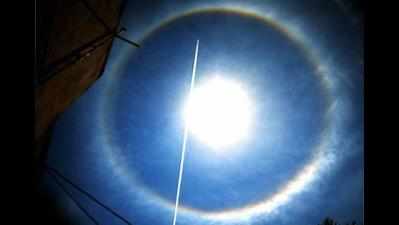- News
- City News
- indore News
- Solstice day: Shadows give a miss to Dongla
Trending
This story is from June 22, 2016
Solstice day: Shadows give a miss to Dongla
In a rare astronomical phenomenon, shadows vanished for a while in Dongla village of Ujjain district in Madhya Pradesh on Tuesday, the longest day of the year.

(Representative image)
Indore: In a rare astronomical phenomenon, shadows vanished for a while in Dongla village of Ujjain district in Madhya Pradesh on Tuesday, the longest day of the year. The day celebrated as summer solstice brings about 17 hours daylight across most European countries. Shadows gave a miss in Dongla, through which Tropic of Cancer passes, as sun passed through over it at around noon.
"Sun was positioned on Tropic of Cancer on Northern hemisphere at around 12.28pm. This position was exactly on top of Dongla village creating a phenomenon wherein shadows of objects vanished for a minute," said Government Jivaji Observatory (Ujjain) superintendent Dr Rajendra Prakash Gupt while talking to TOI.
Awestruck school children and adults gathered at the observatory to witness the rare phenomenon witnessed once a year on solstice. In Northern hemisphere, Tuesday was the longest day with 13 hours and 34 minutes and shortest night with 10 hours 26 minutes of the year, Dr Gupt said.
"Sun assumes the unique position as the earth is tilted (23.5 degree). It is seen moving towards the South as the day progresses," he said.
With the help of the shadow of the gnomon, the angle of elevation and zenith distance of the sun can be determined.
"Sun was positioned on Tropic of Cancer on Northern hemisphere at around 12.28pm. This position was exactly on top of Dongla village creating a phenomenon wherein shadows of objects vanished for a minute," said Government Jivaji Observatory (Ujjain) superintendent Dr Rajendra Prakash Gupt while talking to TOI.
Awestruck school children and adults gathered at the observatory to witness the rare phenomenon witnessed once a year on solstice. In Northern hemisphere, Tuesday was the longest day with 13 hours and 34 minutes and shortest night with 10 hours 26 minutes of the year, Dr Gupt said.
"Sun assumes the unique position as the earth is tilted (23.5 degree). It is seen moving towards the South as the day progresses," he said.
The entire movement of the sun and shadow-less-period was documented using a Shanku Yantra (vertical gnomon) - a traditional Indian astronomical device installed at the observatory, which was constructed by Maharaja Sawai Jaisingh of Jaipur in 1719.
With the help of the shadow of the gnomon, the angle of elevation and zenith distance of the sun can be determined.
End of Article
FOLLOW US ON SOCIAL MEDIA










